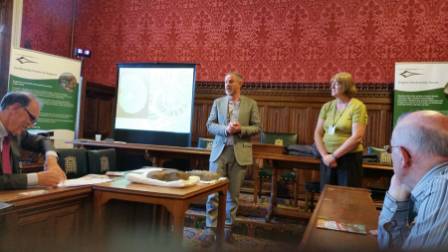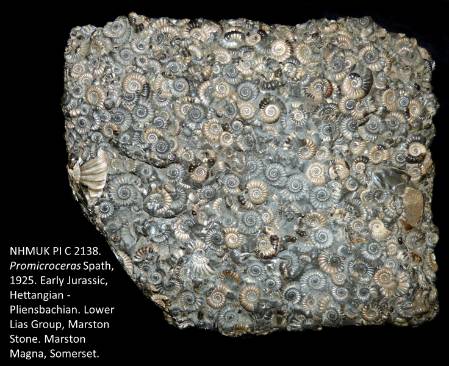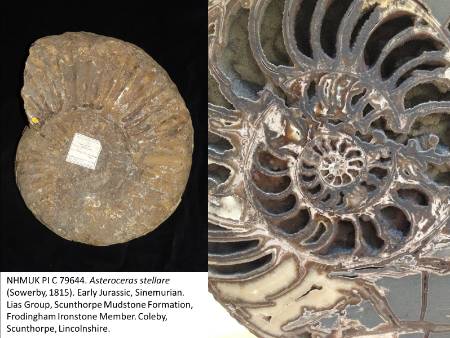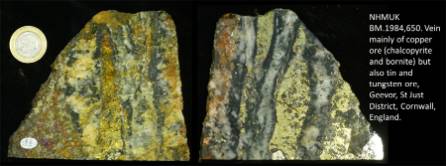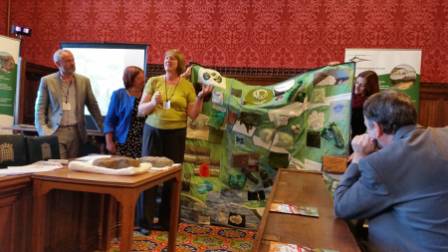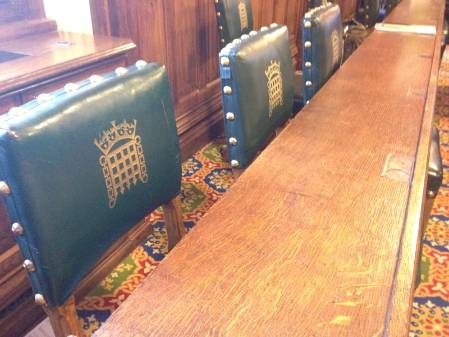I was asked to present a short talk at the Houses of Parliament using specimens from the Natural History Museum collections at the launch of the English Geodiversity Charter on 21 October. The charter has been drawn up by the English Geodiversity Forum. I am currently Chairman of the Geological Curators' Group (GCG), who have been campaigning for examples from museums to be included in the Charter. This post outlines geodiversity, the charter launch and why museums are vital for education about geodiversity.
Show and tell specimens on the desk and on the screen during my talk
(photo courtesy of Paolo Viscardi, Chairman, Natural Sciences Collections Association).
What is geodiversity?
To quote from the Charter: 'Geodiversity is the variety of rocks, minerals, fossils, landforms and soils, together with the natural processes that shape them. Geodiversity is a foundation for life and our society. It influences landscape, habitats and species as well as our economy, historical and cultural heritage, education, health and well-being.' In short, geodiversity underpins biodiversity.
Who was at the briefing?
The briefing was convened by Julian Smith MP, opened by Lord de Mauley (Parliamentary Undersecretary for Natural Environment and Science) and was closed by Andrew Sells (Chairman of Natural England). Various MPs had been invited including Kenneth Clarke who was present as his constituency includes Keyworth, Nottingham, the home of the British Geological Survey. Various representatives of the organisations supporting the charter made up a total of about 50 people.
Who was speaking?
The main speakers were Prof Rory Mortimore (Vice President, Geologists’ Association) who spoke on Geodiversity – why it is important?, followed by Lesley Dunlop (Chair, English Geodiversity Forum) on Geodiversity Charter for England and the English Geodiversity Forum.
After a short question and answer session there were a number of short presentations:
- Sam Rose (World Heritage Site Manager, Jurassic Coast Team) – the global importance of England’s geodiversity illustrated through the Jurassic Coast World Heritage Site.
- Melanie Border (Chair, UK Geoparks Forum) – The importance of Global Geoparks.
- Rob Palmer (Aggregate Industries) Geodiversity and the Mineral Industry – a personal perspective.
- Graham Worton (Keeper of Geology, Dudley Museum and Art Gallery) - Dudley Bug – Geodiversity shaping local communities.
- Giles Miller (Natural History Museum) – The importance of museum collections with an opportunity to view some specimens from the Natural History Museum.
- Christine Taylor (Hampshire County Council) - the Hampshire Geological quilt from The Rockband Project.
Museums inspire and educate the geologists of the future
The first rock type I showed in my talk inspired and fascinated me as a child. I would always go to the example on display in the Earth Galleries of the old Geological Museum in South Kensington and stare in wonder. There is still an example of this rock on display that has been shaped like a gravestone to show that the deposit is sometimes called an ammonite graveyard.
The loan for the ammonite specimens was kindly processed by Zoe Hughes, Curator of Brachiopods and Cephalopods, Department of Earth Science, Natural History Museum. We were worried at one point that the specimens would not be allowed entry to Westminster Palace because rocks are classed as offensive weapons!
I cannot pass this display, even if I am rushing off to a meeting, without stopping to look at the specimen and read how these beautiful fossils formed one deposit so many millions of years ago.
Museum specimens highlight local issues
After joking that I wasn't being very geodiverse by choosing two Jurassic ammonite examples, I lifted up a rather heavy example of an ammonite from the Frodingham Ironstone Formation. This specimen is unprepared but polished ammonites (like the one below right) from this Jurassic Formation of North Lincolnshire can fetch over £1,000 pounds. The image on the right is a beautiful cut section from the example of this species on display in the Lasting Impressions Gallery at the Natural History Museum.
I didn’t chose this example because of its value but because it is relevant to a local issue relating to a North Lincolnshire site known as 'the Rockstore' that was set up by Scunthorpe Museum to showcase the Frodingham Ironstone Formation. This site hosts hundreds of tonnes of Frodingham Ironstone and has been left open for local schoolchildren, geologists both amateur and professional to view and collect the ironstone formation that has had such a major impact on the history of the area.
The ironstone was smelted as far back as Roman times. From the 1850s to the 1980s, open cast and subsequently deep mining was carried out until the deposit became unsustainable. Railways opened up to service the area and support the subsequent industrialisation. A local rail and rock museum commemorates this.
The Geological Curators’ Group has been alerted to the fact that the local council want to dispose of the rocks and build an industrial estate on the site. We are not suggesting that the estate plans should shelved but we feel that the relevance of the ironstone to the history of the local area merits finding an alternative site rather than the disposal of this important rock formation that is no longer available to collect easily from other sites.
Museum specimens illustrating our heritage
My third specimen also had a mining theme to it. It was a vein containing tin, copper and tungsten ore from the Geevor Mine, Cornwall. The brassy parts are chalcopyrite (CuFeS2 ) and the purple iridescent parts are bornite (Cu5FeS4) which are both copper iron sulphides. Mineral-rich veins like these were emplaced in the Devonian age rocks of SW England during the Variscan Orogeny (or mountain-building event) that lasted about 100 million years as the supercontinent of Pangaea formed.
The image shows both the unpolished (left) and polished (right) face of this beautiful specimen. The loan for this specimen was kindly processed by Helena Toman, Curator of Ores, Department of Earth Science, Natural History Museum.
The main effect of the Variscan on SW England was the underground emplacement of a giant granite mass called the Cornubian Batholith about 290 million years ago. While the magma was still hot, minerals became concentrated in hot liquid that migrated and then solidified in veins of tin, copper, iron, zinc, lead, silver and arsenic ore.
These have been extensively mined and left an indelible legacy on the local community and history of the area. The granites continue to dominate the area as they underly large moorlands such as the Bodmin Moor and Dartmoor. Quarries have produced distinctive granite building stones and the weathered margins of the granite have also produced local china clay.
Geodiversity is relevant to us all
Finally, Christine Taylor from Hampshire County Council brought along a geological quilt. A group of museums in SE England recognised that they lacked specialist knowledge about geology and their geological collections so formed a HLF funded partnership called Rockband.
Christine Taylor (Hampshire County Council) demonstrating the quilt showing the geological map of Hampshire (photo courtesy of Paolo Viscardi, Chairman, Natural Sciences Collections Association).
The Geological Curators’ Group was particularly interested in this project because it is a very nice example of sharing skills and knowledge via museum collections. Local geological experts were brought in to devise new geology sessions that have enabled members of the public to understand the relationship between the geology of the local area, building stones and the natural landscape.
Each partner was provided with a bespoke textile geological mat designed to communicate the geological structure of the area. Pockets house examples of local rocks and fossils linked to stories based on the local geological history. These mats were particularly designed for blind and partially sighted people but were relevant to all visitors.
What happens next?
It was an extremely successful launch of the Charter and was a great first step in achieving the aims of the English Geodiversity Forum which are to: encourage ‘action’ for geodiversity, raise awareness of geodiversity, promote and share good geoconservation practice, and advocate policy inclusion of geodiversity at all levels.
It will be interesting to see how we can build on this first step in the light of a forthcoming general election and the lack of geological topics on the national curriculum. Clearly museum collections and displays play a vital role in educating the public about geodiversity so the GCG look forward to working closely with EGF in the future.
And how does this all relate to my role as a micropalaeontology curator? This week I was officially told that my role will change and I will become a collections manager in charge of three members of staff covering the micropalaeontology, petrology and the ores collections. As well as this management role moving me further from hands-on-curation, my job is certainly becoming more geodiverse!



